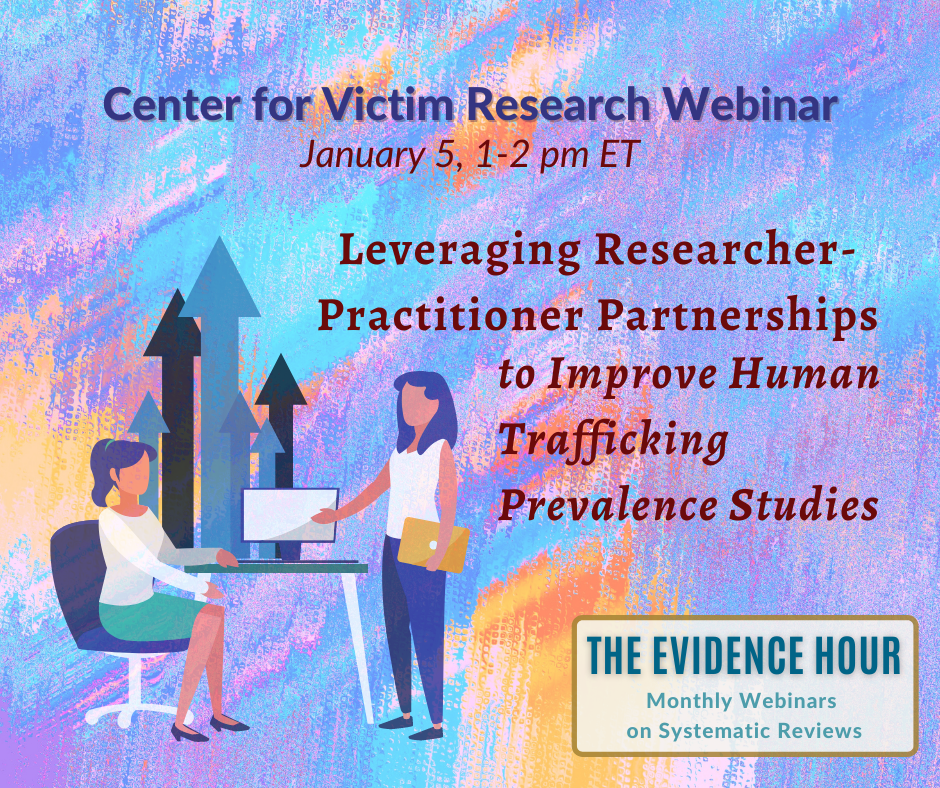The Evidence Hour: Leveraging Researcher-Practitioner Partnerships to Improve Human Trafficking Prevalence Studies

The Center for Victim Research’s webinar series, The Evidence Hour, showcases a recent systematic review* or meta-analysis about victimization, trauma, or victim services. Each webinar features an author of the research and a practitioner discussant who will review the findings and reflect on what they mean for victim service providers and researchers.
On January 5, Rebecca Pfeffer, Ph.D., and Kelle Barrick, Ph.D., shared findings from their scoping review of research methods used to measure the prevalence of human trafficking. Terri Galvan, MPP, shared her experiences as the Executive Director of Community Against Sexual Harm (CASH) assisting sex trafficking survivors through harm reduction and trauma-informed practices and training local law enforcement and other groups on person-centered strategies for helping survivors. The recording is available on the CVR YouTube channel:
This webinar is based on findings from the article: “Advances in measurement: A scoping review of prior human trafficking prevalence studies and recommendations for future research” by R. Pfeffer & K. Barrick. (2021), Journal of Human Trafficking.
Related Research:
- “The Prevalence of Sex Trafficking of Children and Adolescents in the United States: A Scoping Review“ by. H. Franchino-Olsen, H. et al. (2022). Trauma, Violence, & Abuse, 23(1), 182–195. This article clarifies what prevalence can mean, using K. J. Rothman (2012)’s definition [emphasis added]: “the proportion of cases in a population either at a specific point in time (point prevalence), during a given time period (period prevalence) or at some point in one’s lifetime (lifetime prevalence).” The review covers six articles published between 1999 and 2017 about commercial sexual exploitation of children/domestic minor sex trafficking (CSEC/DMST) and found that three of the studies methods focused “on the number of youth at-risk of DMST/CSEC” and the other three focused on “prevalence of previous or ongoing DMST/CSEC victimization.” The researchers noted a need for more studies with nationally representative samples that focus on actual victims, rather than populations “at risk.” They also suggested using a combination of documented case data and self-report data.
- “A Scoping Review of Human Trafficking Screening and Response” by R.J. Macy et al. (2021). Trauma, Violence, & Abuse. This article compiles 22 screening tools identifying potential trafficking victims and describes the number of questions, setting for use (healthcare, social services, etc.), and the type of trafficking. The authors also noted that 4 of the tools were evaluated for validity/sensitivity. Tables 5 & 6 may be of particular interest, as they provide recommendations for using the tools and steps for following up if someone seems likely to be in a trafficking situation. See also CVR’s Screening & Assessment collection for access to some human trafficking screening tools.
- “Assets and Logic: Proposing an Evidenced-based Strategic Partnership Model for Anti-trafficking Response” by K.M. Preble et al.(2021),Journal of Human Trafficking, Abstract; (Contact the Librarian for full-text). This article can help communities identify their resources that could address survivors’ needs and make a plan for using those resources. The authors also walks readers through creating a logic model to visualize this process and outcomes.
Related Resources from our Research2Practice Network:
- Institute on Domestic Violence & Sexual Assault: Post-Disaster Worker Empowerment Journal Assessment (CVR Research-to-Practice Fellowship) – researcher-practitioner partnership to study program that brings together post-disaster response workers “to assess for risks of violence in the form of labor abuse, exploitation, and trafficking through journaling.”
- Urban Institute: Justice in Their Own Words – Perceptions and Experiences of (In)Justice among Human Trafficking Survivors (2018) – in-depth interviews with 80 human trafficking survivors about their experiences in the criminal justice system and their ideas for what justice would truly mean to them.
- CALiO: Trafficking and Commercial Sexual Exploitation of Minors (updated December 2021) – bibliography of studies related to victims of child trafficking.
*What are Systematic Reviews?
- A systematic review is the process of bringing together all available studies about a well-defined question, analyzing the quality of their study methods, and summarizing their findings.
- Systematic reviews often use a statistical practice called meta-analysis. This means combining data from multiple studies, to find patterns and calculate the average effect of the intervention.
- Because systematic reviews pool results from many experiments and rate the methods of each study, these reviews increase our confidence in the quality and consistency of the evidence and what it means for the field.
Basically, systematic reviews take a large amount of information about a complex issue from multiple sources and make that information more manageable and usable. These reviews can also help make sense of conflicting findings from different studies.
Learn more from:
- Quick Reference: Systematic Reviews
- Quick Reference: Tips on Reading Research Articles
« PREVIOUS NEXT »

Leave a Reply